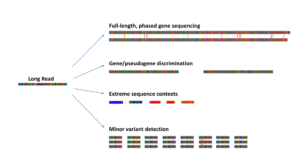Will the next big cancer breakthrough be in immunotherapy? Therapeutic modification of the tumor microenvironment or microbiome? Or early detection and screening?
Whatever the result, long-read sequencing technology can play a pivotal part in the discovery process, according to Meredith Ashby, PacBio’s director of Market Strategy for Microbial Genomics, Cancer and Immunology.
In a recent article for Lab Compare, Ashby highlighted some of the ways Single Molecule, Real-Time (SMRT) Sequencing has given researchers a deeper understanding of tumors at the genomic and transcriptomic level.

By spanning very large structural variants in single reads, SMRT Sequencing can provide clarification in cases where variants may be acting in concert to affect treatment response. Ashby describes recent work where scientists at Memorial Sloan Kettering Cancer Center and other institutes used SMRT Sequencing to explore why certain patients are “super responders” to alpelisib, a targeted PI3Kα inhibitor. The ability to phase all variants along PIK3CA transcripts revealed that patients with distal mutations in cis showed remarkably improved response to therapy, as compared to those who had only a single mutation, or whose mutations were present in trans.
Long reads can also help determine cancer risk status involving ‘hard to sequence’ genes which have highly homologous, inactive pseudogenes. For example, long reads can distinguish SNVs, indels and larger rearrangements in PMS2 from those in the inactive pseudogene, PMS2CL.
Finally, generating full-length transcripts via the Iso-Seq method can disambiguate isoforms to provide insights into cancer biology or serve as better biomarkers. Long reads can reveal cryptic exons, retained introns, and other splicing changes that are often cancer-specific and therefore may be missing from the gene models typically used to aid short-read transcript assembly, Ashby noted. Ashby cited an example where targeted SMRT Sequencing of androgen receptor (AR) isoforms revealed that the structure of AR-V9 was previously mischaracterized, and that the corrected isoform information could be used to improve the prediction of drug resistance in prostate cancer.
“While a decade-plus of short-read data has produced truly exciting information for the cancer research community, there is much more to be learned simply by looking through a different lens,” she said.
Read the full article or visit our cancer focus page to find out more about how SMRT Sequencing can drive your cancer discovery research.
April 28, 2020 | Cancer research